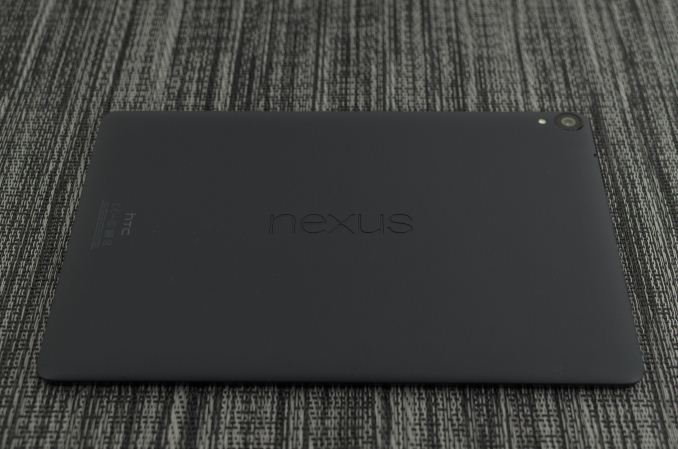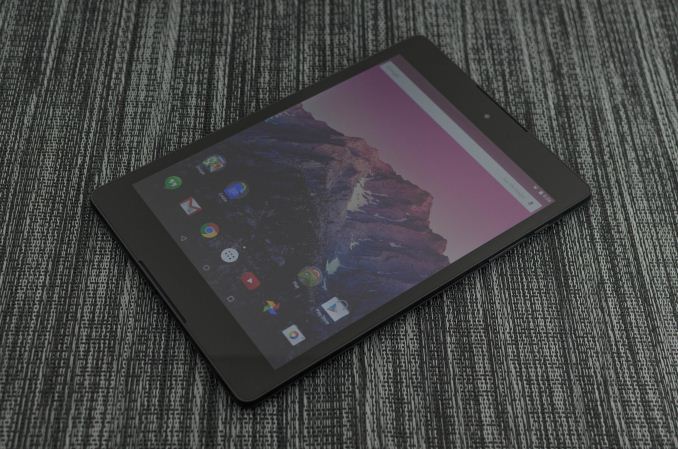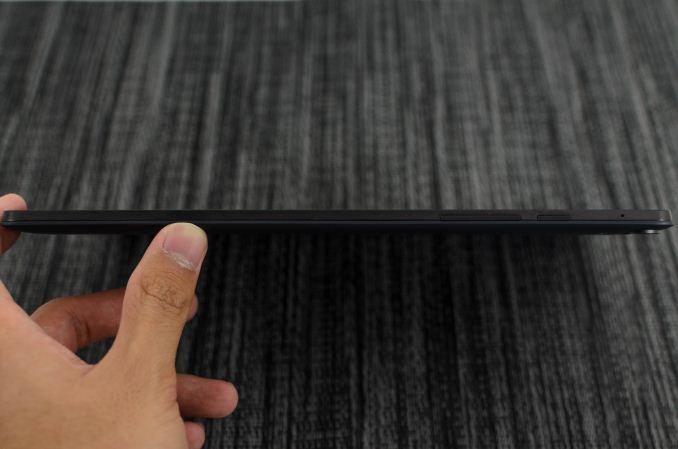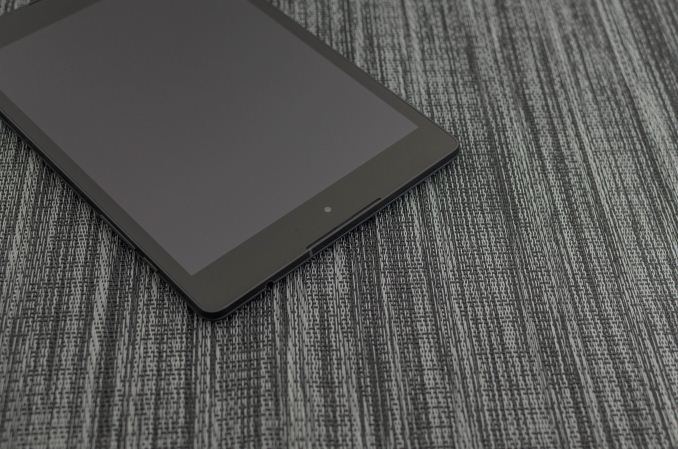Google Nexus 9: Preliminary Findings
by Joshua Ho on November 3, 2014 1:00 PM EST
For a few years now, Google has had a generally consistent tablet strategy. Instead of chasing after the ~10 inch tablet segment and focusing upon the high end, we’ve seen tablets closer to the ~7 inch display size at extremely low cost. While this has been an immensely successful strategy in driving hardware adoption, the formfactor made it possible for the tablet to be closer to a large phone than a small tablet. The flexibility of Android’s scaling system meant that an app designed for a phone worked acceptably well for a small tablet, even if the space efficiency was a bit poor. There’s no question that the Nexus 7 (2013) was and still is a great tablet, but even now it’s obvious that there’s a dearth of applications designed specifically for the larger display. The other issue is that of cost. With the Nexus 7 line, Google managed to integrate an incredible amount of hardware into a tablet priced well below the ~500 USD price point that the original iPad established. This is great for the consumer and no doubt great for Google, but the Nexus 7 line was good enough that there wasn’t much in the way of competition.
This brings us to the Nexus 9, Google’s attempt at changing the Android tablet space. From the start, this device seems to be intent on pushing the Android tablet to a more premium segment. Rather than a purely cost-optimized polymer design, we see the addition of an aluminum ring that runs around the side of the device, which definitely helps with in-hand feel. The tablet itself seems to have high-end aspirations as the launch platform for NVIDIA’s Tegra K1-64, which has two Denver CPU cores rather than the traditional 4+1 Cortex A15 setup, along with dual front-facing speakers and a large 9” display with 4:3 aspect ratio. I’ve included the basic specs in a spec sheet below, to avoid spending too much time going over the basics.
| Nexus 9 | |
| SoC | 2.3GHz 64-bit dual core Tegra K1 Denver SoC |
| RAM/NAND | 2GB LPDDR3 + 16/32GB NAND |
| Display | 8.9" 2048x1536 IPS LCD |
| Network | WiFi only or 2G / 3G / 4G LTE SKU |
| Dimensions | 153.68 x 228.25 x 7.95mm, 425g WiFi, 436g LTE |
| Camera | 8MP Rear Facing (IMX219) with F/2.4 aperture, 1.6MP FFC (OV9760) |
| Battery | 6700 mAh (25.46 Whr) |
| OS | Android 5.0 Lollipop |
| Connectivity | 802.11a/b/g/n/ac + BT 4.1, USB2.0, GPS/GNSS, NFC |
Unfortunately, in the case of the Nexus 9 while we can make some early observations the version of firmware that we received dates was built on August 29th, and in the time since it’s quite likely that there have been significant changes in all directions. We still don't have a newer build, so all the tests will be done on older firmware. The full review will have final numbers as it will be done using shipping firmware.
At any rate, the hardware of the Nexus 9 definitely fits the bill of a premium tablet. While for the most part every Nexus device in the past year has shared the same industrial and material design elements, HTC seems to have added a few extra touches to differentiate this product from other Nexus devices. The most obvious and prominent of these touches is the metal ring, which has a brushed texture similar to what we saw on the M8.
There are also dual front-facing speakers that flank the display, which are definitely great for video and music content when compared to a single speaker on the bottom or back of the device. However, for the most part the design is very much a Nexus device with its minimalistic design and soft-touch plastic back cover.













146 Comments
View All Comments
GC2:CS - Monday, November 3, 2014 - link
The question is simple, at what power denver matches the A8X ?If we take the K1 GPU story, we see that Apple has a "bit" lower target for TDP at which the SoC starts to throttle.
Even my two year old laptop is faster than A8X but I didn't saw anyone being interested in that.
chizow - Monday, November 3, 2014 - link
Is your two year old laptop 6-8mm deep and last ~10 hours on 1 battery charge? Then why bother mentioning it.We see in the review, Nexus 9 actually has slightly better battery life than A8X, so I'd say it matches A8X now at current TDP which is estimated on all these SoCs to be about 4.5W. With the benefit of 20nm it would undoubtedly beat A8X either via more transistors (as Apple did) or higher clockspeeds.
mkozakewich - Monday, November 3, 2014 - link
Yeah, what he's saying is that the raw performance doesn't matter if it's not taken in context with the size and battery life and such. He's arguing the same thing as you.chizow - Monday, November 3, 2014 - link
Uh, no except he was comparing two devices in the same class with similar form factors with a 3 year old laptop that is probably 5x thicker with 1/5th the battery life. If he was trying to draw parallels he did an exceptionally poor job at doing so. How is comparing the performance of the Nexus 9 to iPad Air 2 SoCs the same as trying to draw a similar comparison with a 3 year old laptop? Everything that makes the tablet interesting goes out the window on something in that huge clunky form factor.Alexvrb - Monday, November 3, 2014 - link
He was clearly exaggerating to make a point. Performance doesn't everything by itself, especially in situations like this. The A8X is a good chip, and it's more efficient than Denver. Give Denver a die shrink and the tables should turn.chizow - Tuesday, November 4, 2014 - link
He made a pointless point I guess then, because the A8X and K1 are very close in terms of performance and efficiency to the point I'm not sure anyone could make an accurate assessment based on what we know.Air 2 has a bigger screen, but the N9's screen is brighter.
Air 2 has a bigger battery, and the N9 has better battery life.
So again, how exactly do you know the A8X is more efficient than Denver?
DERSS - Wednesday, November 5, 2014 - link
Just look at manufacturing norms. Wonders belong to magic farytales, hard reality tells that 20 nm is much more energy efficient than 28 nm.As result, on heavy load NVidia K1 Denver will fall dramatically, if the load is prolonged. There is no other way, because otherwise battery life under load would be drastically lower than on iPad Air 2.
Alexvrb - Friday, November 7, 2014 - link
So, before you evangelize Nvidia products, do you actually read the articles?"As always, our battery life tests are all run with the display calibrated to 200 nits."
Anandtech has been doing this very same procedure for a long time.
tuxRoller - Tuesday, November 4, 2014 - link
The N9 has essentially the same battery life as the larger screened (larger power draw), smaller battery ipad.The ipad is also using much lower clocks on their cpu, and their gpu looks to be at least a match to the tk1.
Apple is on 20nm, and that's a big deal, but performance doesn't change things significently.
Pretty dissapointed with this nvidia effort.
Hoping from more with the upcoming cortex a57.
kron123456789 - Tuesday, November 4, 2014 - link
Well, iPad's battery is larger. And Cortex A57 is already here - Galaxy Note 4.